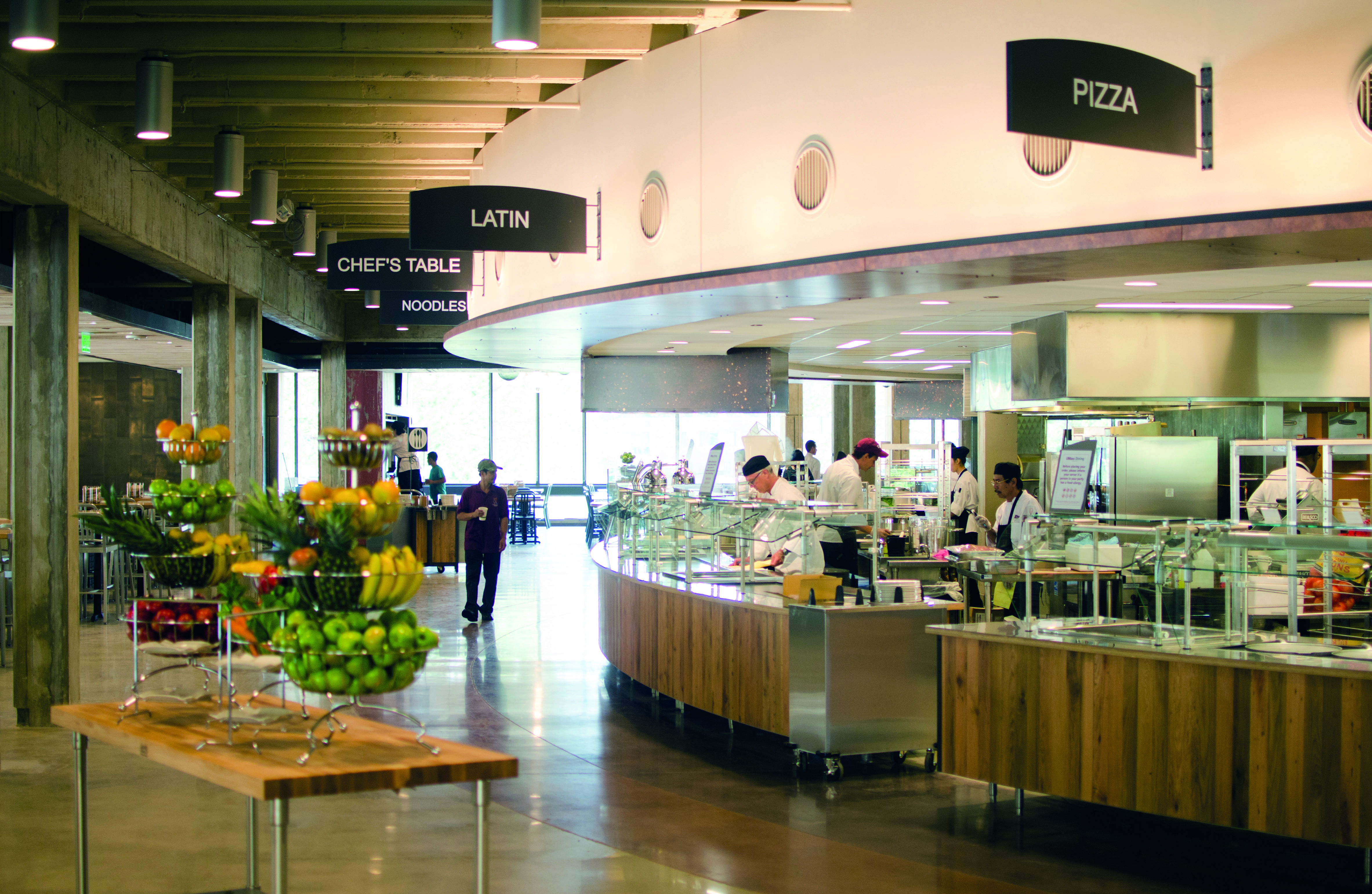
Ramen noodles are the quintessential college food, but these days, they are freshly made, or better yet, pulled. Sustainability, diversity, flexibility, quality, less meat, more plants and access to online ordering are all new ingredients on the college food menu that are forcing operators to respond on everything from menu offerings, equipment considerations and even in communications.
College food today isn’t just a meal card and a stale bagel or flimsy salad bar; it’s a source of community, an identity and a way to experience the world. “The old days of scooping food on the plate and just feeding people have changed,” says Al Ferrone, senior director at UCLA. “We are nourishing people and offering variety. The whole perception has changed.”
UCLA is one of the many programs excelling in this sector. Ranked number one by Niche magazine for college food two years in a row, the program offers four restaurants, including one of the country’s first health-themed food hall concepts, four original QSR concepts and late-night online pizza and wing ordering concept.
Across the country, the University of Massachusetts-Amherst (UMass) run by executive director of auxiliary enterprises, Ken Toong, boasts the single largest dining operation based on revenue and is ranked number one by Princeton Review. It offers students four dining commons, over 30 retail cafes, kosher and halal options, two food trucks and a delivery service among other things.
Smaller institutions such as Bowdoin College in Maine, which ranked number one last year in the The Daily Meal’s annual list of best school programs, show that size doesn’t matter when it comes to what students value in this space. Bowdoin is consistently applauded in the industry for its steadfast commitment to local sourcing, fresh ingredients, global flavors and social responsibility.
Foodie culture
Customization, quality, flexibility, made-to-order, online ordering and portability are all things that are important to students, says Kathryn Fenner, principal at research firm Technomic. “Today’s students are a product of foodie culture and they have instant access to information. They are more demanding and have higher expectations.”
This generation also has a higher rate of allergens, so expect programs to reflect this sensitivity, and are interested in global cuisine. Many operators are seeing where more plant-based options or “plant-forward” menus are important to this population making meatless Monday more like meatless every day. Mary Lou Kennedy, executive director of dining services at Bowdoin says the most dramatic change she has seen is the increase in popularity of vegetable and legume-based meal items and the volume of salads and salad ingredients.
Sustainability and social responsibility is a huge driver and can be seen reflected in larger national initiatives that strive for a more sustainable food economy like Menu for Change and Real Food Challenge.
John Turenne FCSI, owner of Sustainable Food Systems and former Yale executive chef, says that although this generation is interested in doing what’s socially right for people and the planet, they also gravitate back to variety and new concepts. “The challenge for the operator is to source ingredients with a socially just background and turn these into non-traditional fare.”
If that wasn’t enough, students also still expect value for offering. “Our students and families are sensitive to the cost of their education. So while people are adventurous, they still want to get good value,” says Patti Klos at the National Association of College and University Foodservices.
Lifestyle choices
Choosing a college is a milestone decision, and for many students, an institution’s foodservice program can be a big influencer. In a recent survey conducted by UMass, 70% of students said they chose the school for its food. In a 2017 Technomic survey, 57% of students said foodservice was at least somewhat important in their consideration.
Kennedy says dining can be the next deciding factor once students have selected a college based on academics and location, while Ferrone suggests that a dining program may have more influence in the enrollment process. “If a student is trying to decide between schools that have an equal academic offering, I think the living environment becomes the next decision maker.”
Students are the biggest influencers in the sector, but operators say parents are important as well, since they will be paying for the service. Turenne also points to a new emerging influencer: faculty and departmental heads from environmental or health classes. “These movers and shakers have a significant following among the foodservice customers, thus can impact projects and concepts surrounding social and nutritional wellbeing.”
For this technology-centric audience, this sector is responding with digital technology such as touch-screen ordering, digital menu boards, text alerts and digital applications such as Tapingo, an app that lets students pre-order, customize and pay for their meal then pick it up later. Some campuses are also joining the ranks of QSR and full-service restaurants by partnering with third-party delivery programs like Grubhub.
Self-operating or outsourcing
Equipment and layout have also been affected. “Design needs the flexibility to accommodate changes in trends and the ability to change programming throughout the week, for instance, the ability to isolate allergens, locations for events and education and specialty stations,” says Kennedy.
Turenne says a new concept of hoodless cooking technology has enabled operators to have more flexible options across campus while Toong says the biggest shift he sees is the increase in hot food offerings at grab-and-go sites. He believes the industry will also see an increase in pop-up concepts with induction overtaking ventless equipment and says equipment that can multitask and provide “surge” service while bringing fun and entertaining experiences is also key.
Smaller operators with fewer resources can face challenges amid growing student demands and trends. “Equipment is one of the most challenging things we face,” says Mary Reilly, executive chef at Westfield State University. “When I have to look at what we are offering, in many cases, I’m limited by my equipment.”
Historically, foodservice management firms such as Sodexo and Bon Appetit have filled the operational role in college programs, accounting for 51% of all programs in 2016, according to Technomic, with growth expected to reach 61%. Independent operators Toong and Reilly think that trend may be shifting.
Westfield State University is an example of a smaller program that made the shift to independent two years ago, citing the need to be more flexible to changes and student demands. “By being self-operated, we are driving dollars back to our community base. Having the institution drive that makes sense and brings the foodservice closer to the institution’s mission,” says Reilly.
Not all institutions have the resources to self-operate, however, and Fenner says foodservice management firms still play a significant role in helping programs of all sizes manage rising food costs and recruitment challenges. Turenne notes that foodservice management firms are being forced to become more transparent in contract negotiation due to growing concerns about purchasing sustainable food and supporting local, but Toong says there is a place for both identities. “The future is bright for both sides.”
Today’s students are tomorrow’s consumers, and this sector is an excellent indicator of things to come as trends implemented now will need to be reflected when this hungry and demanding population gets out into the real world. K-12 schools, corporate dining and healthcare are all benefitting from the focus on sustainability and menu variety, and Ferrone even speaks to broader impacts to full-service. “Students don’t have a lot of dining experience, so we are setting the expectation high. When they get out, they are going to look at restaurants just a little differently.”
While institutional foodservice has previously been given the cold shoulder, Klos points to the stability of the industry as an opportunity for those seeking foodservice careers. “We are in a unique position now that we have many openings on our campuses and not enough bodies to fill them. My generation is leading these organizations at the moment, but we will be retiring in the next few years and trying to identify succession plans. Being able to convince people that college is a great part of the foodservice world is going to be important.”
Brandy Gonsoulin




